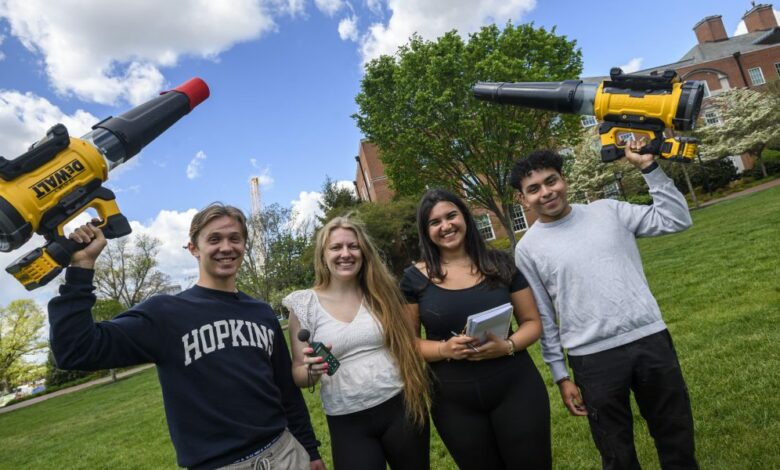College students invent leaf blower silencer for Black and Decker

Suburban dwellers hoping to sleep in on the weekend might want to thank a group of engineering students from Johns Hopkins University. Four undergraduates designed a new leaf blower silencer that quiets the otherwise raucous piece of machinery.
The four designed the product as part of their senior capstone in the university’s Whiting School of Engineering, under the sponsorship of Stanley Black and Decker, the world’s largest tool company with $15.8 billion in annual sales. Stanley was so impressed with their invention, it decided to sell it to the public, and the silencer is expected to hit shelves within the next two years at a yet-to-be-determined price, according to the company.
The product itself is what the group calls a “helical cap” that swirls air around the nozzle of the leaf blower to lessen the noise. The specific geometrical design of the cap, the students explained, shifts the soundwaves that come out of the blower’s long nozzle—the same way a car muffler or a silencer on a gun works. The trick was reducing the blower’s noise while still having it blow enough air to actually be able to clean up a leaf-strewn lawn, said Michael Chacon, one of the students on the project. (Chacon plans to work for a small aerospace company when he graduates.)
Leaf blowers have long had a reputation for being a disruptive part of suburban life, with their distinct monotonous roar a staple of autumn leaf-gathering across the U.S. Aside from being an irritating, if convenient, alternative to raking leaves manually, leaf blowers also represent a $1.5 billion global industry as of 2022, according to market research firm Research and Markets.
As they investigated quieter leaf-clearing, the group impressed both their professors and Stanley Black and Decker.
“This was an especially tight-knit, cohesive, focused group,” said the students’ academic advisor and Johns Hopkins engineering professor Stephen Belkoff. “They hit the ground running. They’re a fun group.”
A Stanley Black and Decker manager, Nate Greene, advised the students. Greene himself was both a graduate of Johns Hopkins and a former student of Belkoff’s. That made it “especially rewarding,” Belkoff says—adding that Greene was “a bit of a taskmaster” with the students.
The cap looks rather unassuming, a plastic cylindrical attachment that is screwed onto the end of the blower, but its results are notable, reducing the contraption’s overall noise by 37%. “The invention dramatically improves the quality of the noise, specifically targeting the frequencies the human ear is most sensitive to,” Greene said. The group went through about 40 versions of the helical cap before they landed on the final one, according to Chacon.
Stanley Black and Decker was so eager to get the leaf blower silencer in stores that it dispatched patent attorneys to secure a patent application on behalf of the four students. The patent is now pending. Madison Morrison, one of the group members who says she’s off to do her PhD when she graduates later this month, called the patent a “big accomplishment” that gave her a new perspective on engineering.
“That process was really cool, because it was a little bit of a different side of the engineering field,” Morrison said. “How do you prove your invention? How do you fully capture it from a legal perspective?”
As part of Stanley Black and Decker’s agreement with Johns Hopkins, the company retains all the intellectual property and subsequent royalties from their design, but the students’ name will appear on the patent.
For their part, the students said they enjoyed the process of going from ideation to a product that a business can sell. “This was a cool example of how you can take something super theoretical, that’s maybe only some research idea, and then actually put it into practical use,” Morrison said.
Toward the end of the project, Greene asked the group to redesign their product so it could be manufactured using an injection mold, which is better suited for mass production, instead of 3D printing, which they had used for their prototypes, according to Andrew Palacio, a member of the group. That’s when they realized Stanley Black and Decker saw real potential in their design.
“Our sponsor [Greene] sat down with us one day a few months ago and had a very stern order to find a way to mass produce the cap,” Palacio says. “That’s when I at least realized, ‘oh this is probably going to end up on a shelf one day.’”
But one thing the group is still not sure of—their grades. When asked if they got an A, all four laughed, “We don’t know yet.”
Source link




